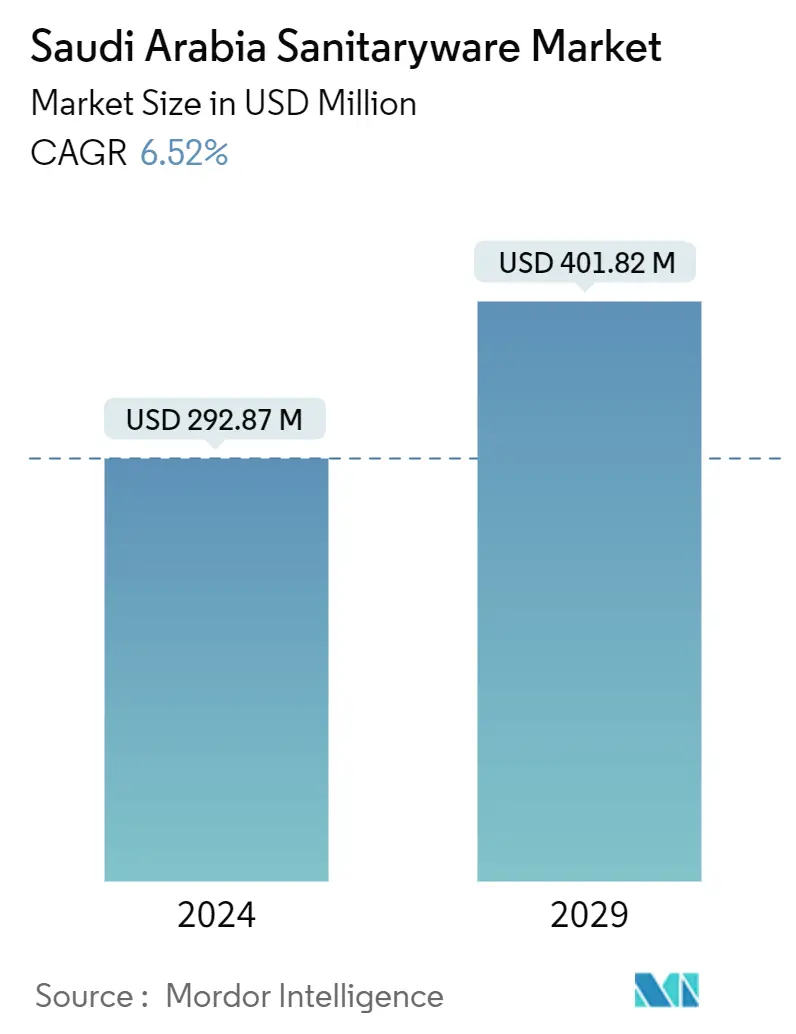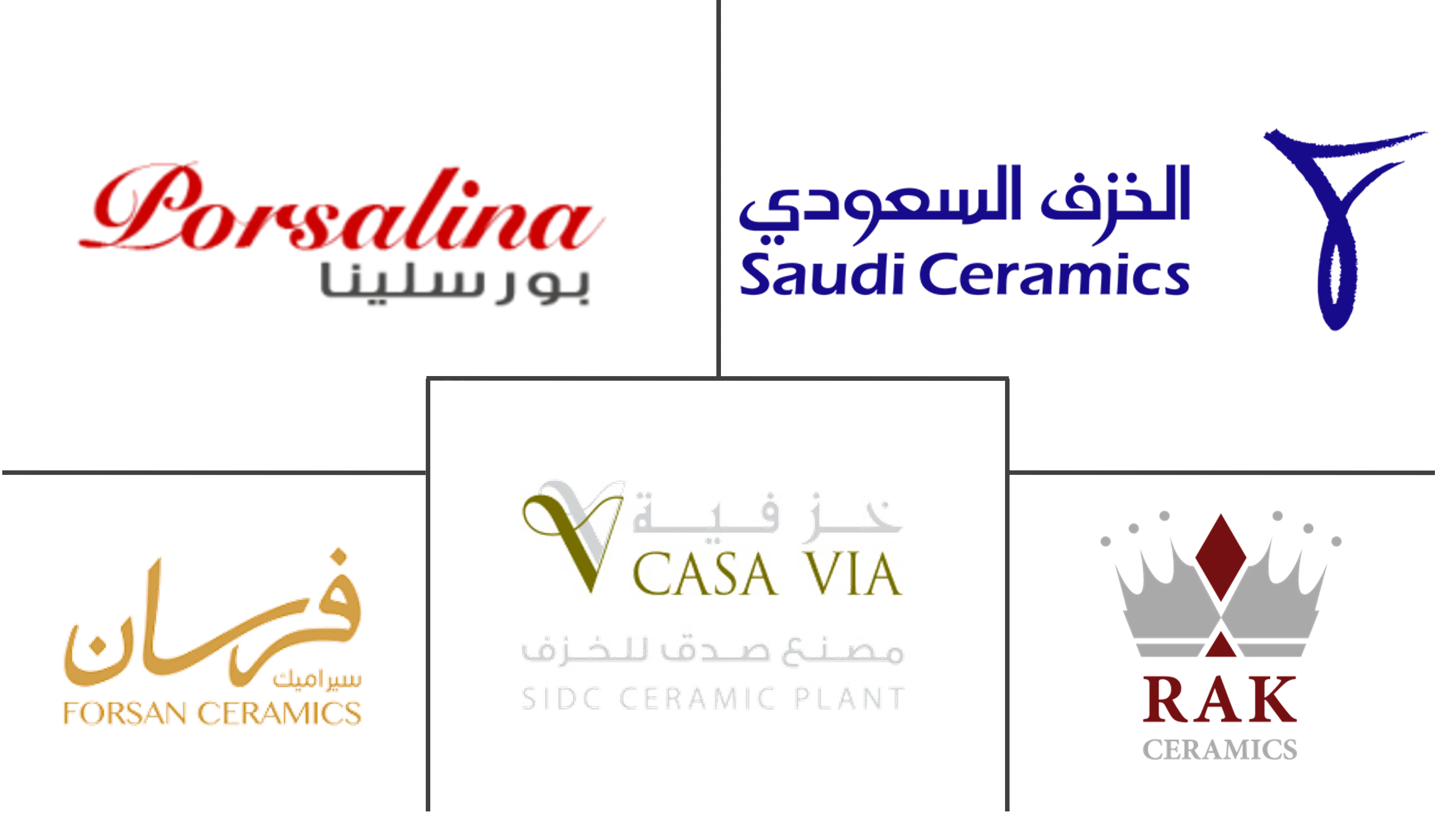Market Size of Saudi Arabia Sanitaryware Industry

| Study Period | 2020 - 2029 |
| Base Year For Estimation | 2023 |
| Market Size (2024) | USD 292.87 Million |
| Market Size (2029) | USD 401.82 Million |
| CAGR (2024 - 2029) | 6.52 % |
| Market Concentration | Medium |
Major Players
*Disclaimer: Major Players sorted in no particular order |
Saudi Arabia Sanitaryware Market Analysis
The Saudi Arabia Sanitaryware Market size is estimated at USD 292.87 million in 2024, and is expected to reach USD 401.82 million by 2029, growing at a CAGR of 6.52% during the forecast period (2024-2029).
In the last few years, the market for sanitary products in Saudi Arabia has grown significantly. In the Gulf Cooperation Council, Saudi Arabia has emerged as one of the most important manufacturing centers for cleaning products. The growth of the market is driven by government initiatives to promote housing affordability and an increase in demand from businesses and industries, for instance, hotels, offices, schools, and universities. In view of the increasing demand for housing from both local and immigrant populations, the real estate sector is expected to continue to experience healthy growth. It is anticipated that this will continue to drive the growth of the sanitary ware product market. Moreover, the growth of demand is expected to be driven by a growing purchasing power for consumers.
Smart home adoption and infrastructure developments in the world are expected to have a positive impact on the demand for hygiene products. Moreover, demand for sanitary products in the housing sector is being driven by changes in building interiors. As homeowners upgrade their existing sanitary ware to newer products that offer better visual appeal or function, residential remodels and replacements are likely to continue to represent the majority of demand for ceramics sanitary ware.
As consumers and producers seek to meet sustainability standards, there is a growing demand for these products from the adoption of strict guidelines and incentives on energy-efficient toilet installations. Disposable income has also increased, allowing more people to spend on quality sanitary products as a result of the growth of the real estate sector and the growing middle class in emerging economies.
Saudi Arabia Sanitaryware Indsutry Segmentation
Sanitary ware, also known as plumbing ware, is a term used to describe plumbing fixtures, fittings, and other plumbing-related products used in bathrooms and kitchens. The purpose of sanitary ware products is to create a sanitary and visually appealing environment for users.
The Saudi Arabian sanitary ware market is segmented by product, material, distribution channel, and end user. By product, the market is segmented into water closets, wash basins, pedestals, cisterns, and other product types (bathtubs, showers, bidets, etc). By material, the market is segmented into ceramics, metal, plastic, and other materials (porcelain, etc). By distribution channel, the market is segmented into home centers, specialty stores, online, and other distribution channels (dealer franchisees, etc.), and by end user, the market is segmented into residential and commercial.
| Product | |
| Water Closets | |
| Wash Basins | |
| Pedestals | |
| Cisterns | |
| Other Products |
| Material | |
| Ceramic | |
| Metal | |
| Plastic | |
| Other Materials |
| End User | |
| Residential | |
| Commercial |
| Distribution Channel | |
| Home Centers | |
| Specialty Stores | |
| Online | |
| Other Distribution Channels |
Saudi Arabia Sanitaryware Market Size Summary
The sanitary ware market in Saudi Arabia is experiencing significant growth, driven by various factors including government initiatives to enhance housing affordability and increased demand from sectors such as hospitality, education, and commercial enterprises. The real estate sector's expansion, fueled by both local and immigrant populations, is a key contributor to this growth, as it boosts the demand for sanitary products. Additionally, the rise in consumer purchasing power and the adoption of smart home technologies are further propelling the market. The trend towards upgrading residential interiors with modern sanitary ware is also contributing to the market's expansion, as homeowners seek products that offer improved aesthetics and functionality.
The market is characterized by a growing emphasis on sustainability and energy efficiency, with consumers and producers increasingly adhering to strict guidelines for eco-friendly installations. The luxury segment of the market is gaining traction, driven by the demand for high-end fixtures in luxury housing and smart homes. Technological innovations and heightened hygiene concerns are prompting the adoption of advanced, touchless sanitary solutions. The market is moderately fragmented, with major players like Saudi Ceramics and RAK Ceramics leading through strategic expansions and acquisitions. The construction and hospitality industries are expected to further stimulate demand, supported by increased infrastructure spending and tourism growth in the region.
Saudi Arabia Sanitaryware Market Size - Table of Contents
-
1. MARKET INSIGHTS AND DYNAMICS
-
1.1 Market Overview
-
1.2 Market Drivers
-
1.2.1 Ceramic Ware Driving the Market Segment
-
1.2.2 Growth in Construction Sector Driven by Government Initiatives
-
-
1.3 Market Restraints
-
1.3.1 Fluctuating Raw Material Prices
-
1.3.2 Competition from Low-cost Products
-
-
1.4 Market Opportunities
-
1.4.1 The Focus on Energy Efficiency and Speed of Installation is Expected to Drive Further Growth in the Market
-
1.4.2 Developing Products Designed to Meet a Wider Range of Hygiene Requirements and to be More Environmentally Friendly
-
-
1.5 Industry Value Chain/Supply Chain Analysis
-
1.6 Porter's Five Force Analysis
-
1.6.1 Threat of New Entrants
-
1.6.2 Bargaining Power of Buyers/Consumers
-
1.6.3 Bargaining Power of Suppliers
-
1.6.4 Threat of Substitute Products
-
1.6.5 Intensity of Competitive Rivalry
-
-
1.7 Insights into Technological Advancements in the Industry
-
1.8 Impact of COVID-19 on the Market
-
-
2. MARKET SEGMENTATION
-
2.1 Product
-
2.1.1 Water Closets
-
2.1.2 Wash Basins
-
2.1.3 Pedestals
-
2.1.4 Cisterns
-
2.1.5 Other Products
-
-
2.2 Material
-
2.2.1 Ceramic
-
2.2.2 Metal
-
2.2.3 Plastic
-
2.2.4 Other Materials
-
-
2.3 End User
-
2.3.1 Residential
-
2.3.2 Commercial
-
-
2.4 Distribution Channel
-
2.4.1 Home Centers
-
2.4.2 Specialty Stores
-
2.4.3 Online
-
2.4.4 Other Distribution Channels
-
-
Saudi Arabia Sanitaryware Market Size FAQs
How big is the Saudi Arabia Sanitaryware Market?
The Saudi Arabia Sanitaryware Market size is expected to reach USD 292.87 million in 2024 and grow at a CAGR of 6.52% to reach USD 401.82 million by 2029.
What is the current Saudi Arabia Sanitaryware Market size?
In 2024, the Saudi Arabia Sanitaryware Market size is expected to reach USD 292.87 million.

